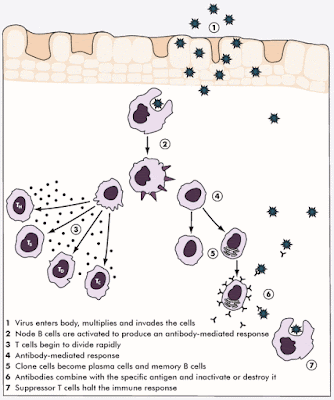Process of system
Virus invades body's first line of defence, fastly multiplies in cells, and is spread through the blood and lymph vessels.
2.- Node B cells are activated to produce an antibody-mediated response:
 When the lymph enters the lymph node, B cells are activated to produce an antibody-mediated response. Also macrophages recognise the virus as a non-self antigen and begin to engulf and destroy the pathogen.
When the lymph enters the lymph node, B cells are activated to produce an antibody-mediated response. Also macrophages recognise the virus as a non-self antigen and begin to engulf and destroy the pathogen.
3.- The T-cells begin to divide fastly:
The T-Helper cells have a receptor in their membrane cleverly called the T-Cell receptor. This is a protein receptor with a specific shape.
4.-Antibody-mediated response:
Helper T cells sensitise B lymphocytes to divide and produce a clone of cells.
Cloned cells
6.- Antibodies combine with the specific antigen and inactive or destroy it:
Neutralisation: Antibodies block active sites on
viruses and bacterial toxins which means they can no longer bind to receptor
sites on tissue cells and cause injury.
Agglutination: Particles such as bacteria,
viruses or foreign blood cells clump together.
Precipitation: Soluble antigens are made
insoluble and then settle out of the solution.
7.- Suppressor T cells halt the inmune response:
Once the active infection or tumor or transplant is destroyed many of the T cells
However, a number of them remain as Memory cells. These cells will respond to the same antigen if it is ever encountered again.
However, a number of them remain as Memory cells. These cells will respond to the same antigen if it is ever encountered again.





No hay comentarios:
Publicar un comentario